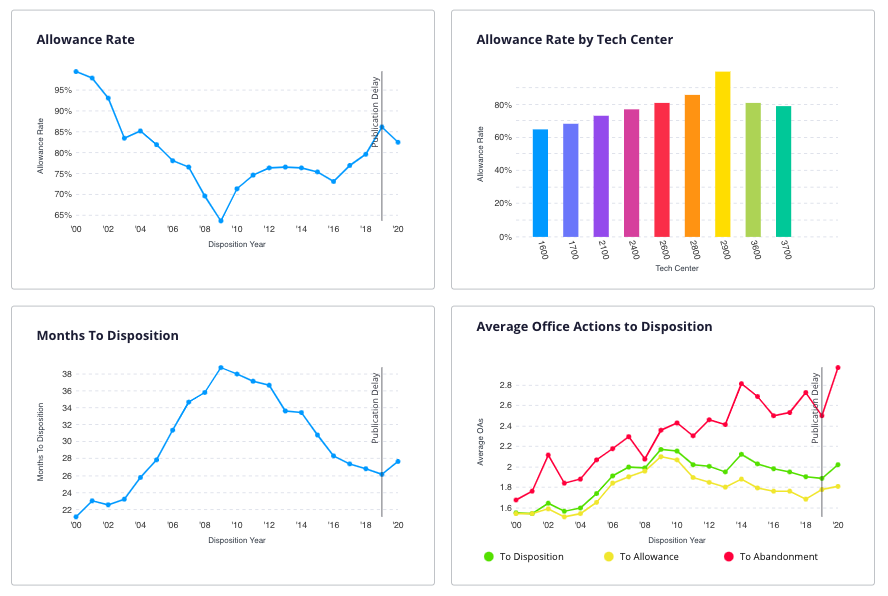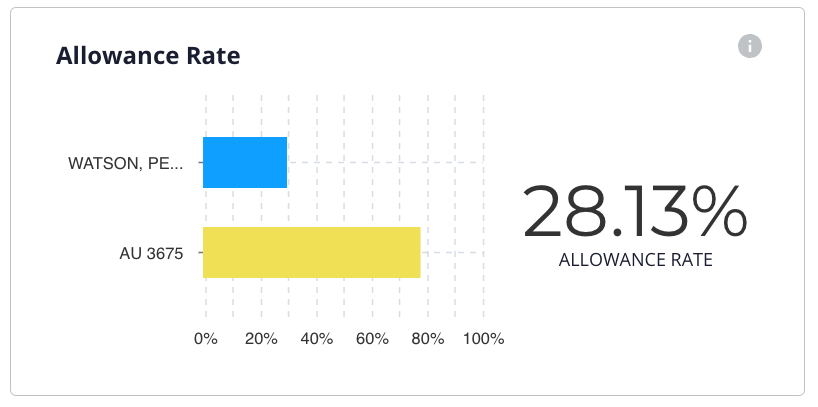As a seasoned patent professional, you are confident in your strategy. But more and more often, your clients are demanding proof of your data-driven decision-making.
So how do you incorporate dense USPTO data into your client communications in a way that allows you to tell a compelling story about the choices made and the life cycle of an application?
Here are four essential tips to help you present data in a way that engages your clients, demonstrates ROI, and establishes consistency in your approach.
1. Make your data visually appealing
Visuals are a powerful communication tool that can captivate your audience and make complex information more digestible.
Juristat Analytics subscribers can export high-quality image files to incorporate into their reporting to clients or to create eye-catching RFPs when they’re looking to win new business. By organizing data in a visually pleasing format, you enhance its impact and improve the likelihood of client engagement.

2. Tie your data to your ROI
Data, on its own, may not resonate with your clients. They’re business-minded and want to know their investment in your services is worth it. You need to demonstrate the cost savings and ROI you bring to the table.
For example, using analytics, your firm can compare your (superior!) OA track record to that of your client’s in-house team or even competing outside counsel. Assuming that the cost for preparation and filing is the same, your average number of office actions could make a big difference in securing a faster and less expensive prosecution. Tying these analytics to true costs can help clients see, in a clear dollar format, the benefit of working with your firm.
Learn more methods to demonstrate ROI in our webinar, Using Data to Show Firm Value to Clients.
3. Track data over time
Metrics and data presented over time can provide valuable insights into growth, change, and trajectory. Historical data enables you to analyze trends and patterns specific to your client's industry, company, or technology.
For example, a quick keyword search in Juristat can deliver data on how patent filings around a particular technology are spiking or declining, if allowance rates are improving, or which rejection bases are becoming more or less common.
With analytics dating back to 2000, Juristat Analytics puts the USPTO data set at your fingertips to inform prosecution decisions, drive business strategy, and more. Metrics can be exported to a spreadsheet for further analysis by your team, or exported as an image directly from the app and easily dropped into a report or presentation.
Sharing trend data like this – and in visually appealing formats, no less! – can boost buy-in and demonstrate the efficacy of your strategy to clients.
4. Make sure your data matters
While broad benchmark data is important and should be part of your regular reporting, providing clients with specific data can help drive home your point…and your expertise.
Sure, you can tell your client you’re facing a particularly difficult examiner, but a clear presentation of that particular examiner’s low allowance rate compared to the rest of the USPTO might help drive the point home and get your client on board with your timeline and strategy.
Take Examiner Peter Watson, for example. While Art Unit 3675 has a fairly high allowance rate of 76%, Watson’s allowance rate is significantly below that. Paying attention to the specific examiner behavior, rather than the broader USPTO or even Art Unit average, should drive the strategy to earn that coveted allowance.

Effectively leverage the data in your favor by honing in on a specific metric. For example, Jonathan Miller of Nicholson De Vos Webster & Elliott LLP explained to Juristat how he used data in his favor with an application that was on the verge of abandonment.
Miller’s client had a small patent portfolio. While the other applications in their portfolio easily earned allowances, there was one application that was experiencing a more difficult prosecution than anticipated.
For this particular application, they were facing a different examiner than they had for the other cases, so Miller turned to our Examiner Reports for more insight.
What he found was that this prolonged examination wasn’t that unusual for this examiner.
Using Juristat, he was able to review the average examination length of that particular examiner, as well as the average examination length within the art unit of the application in question. For most examiners and art units, Juristat is able to provide the average amount of time between key events like filing to first office action, filing to disposition, an RCE to the next office action, notice of allowance or abandonment, notice of appeal to PTAB decision, and notice of appeal to Non-PTAB disposition.
Jonathan shared this data with his client, who agreed to one more response. The next office action they received was a notice of allowance.
Each client (and each application) is unique, but being able to narrow the data to mirror your specific situation helps make better-informed decisions. Juristat Analytics has powerful search and filtering capabilities, allowing you to generate custom analyses using 125+ unique variables.
When it comes to tracking and presenting data over time, consistency is key. Establishing the long-term relevance of key data points can help build trust and familiarity with the information you’re providing. Incorporating examiner, art unit, or competitor analytics into your regular reporting keeps your client informed and in sync with your prosecution strategy and results. Find out how Juristat can make that process easier for your team of patent professionals. Set up a demo.
(gradient).webp)

